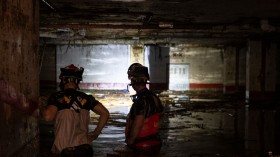A safe place is what many people worldwide today wish to have. The pandemic due to the coronavirus outbreak is getting worse each day, with reported cases now exceeding 190,000. A study has found that the virus has spread very fast due to "stealth transmissions." This might make us think that there is nowhere to go to escape it. However, there is one likely place out of reach of the virus: the ISS or the International Space Station.
The ISS orbits our planet 250 miles above the surface of the Earth. It is operated jointly by the respective space agencies of Canada, Russia, U.S., Japan, and Europe. Russia's Soyuz is the sole means for astronauts to go to and leave the station.
The ISS keeps its crew safe from the coronavirus and other dangerous pathogens by implementing preventive measures before the astronauts leave Earth. With the alarming spread of the virus, space agencies worldwide, including NASA, added new safety precautions that address the COVID-19 pandemic. They continue to regularly assess their measures and mission plans according to new developments.
Astronauts are Quarantined Before Launch
Before launching astronauts to the ISS, great care is taken to prevent the crew from bringing pathogens on board with them. Luis Zea of the University of Colorado Bio Serve Space Technologies disclosed that before launch, the astronauts are observed, quarantined, and tested for symptoms. The quarantine period is two weeks prior to launching in the Soyuz capsule in Kazakhstan.
In addition, NASA spokesperson Courtney Beasley points out that measures are also implemented for cargos transported to the station. According to Zea, items sent to the ISS are cleaned, although not always sterilized. This is in contrast to the sterilization undergone by probes that go to planetary bodies to avoid contanimation from Earth.
In contrast, stringent sterilization is imposed on spacecrafts that land on celestial bodies in space. In the future, this will prevent people from mistaking molecules as an indicator of possible life on those bodies, as they could in fact have been brought by past missions.
For ISS missions, however, the crew comes with the microbes, since total sterilization is not possible anyway. The human body contains more bacteria in it and on its surface than the total number of cells it comprises. Regardless of how the stringent sterilization processes may be, people will always carry bacteria with them.
The combined cleaning and quarantine measures will reduce the likelihood of pathogens gaining access to the ISS, Zea said. This is especially true since the coronavirus cannot survive long periods on surfaces. In addition, infected astronauts are screened out and diagnosed while they are still in quarantine on Earth.
In addition to all the preventive measures, all astronauts are also required to undergo training for medical emergencies, with doctors on Earth that are also in regular contact with them to monitor their health closely. There are also Soyuz spacecraft on the ISS that can serve to ferry the crew should an evacuation back to Earth becomes necessary.
© 2024 NatureWorldNews.com All rights reserved. Do not reproduce without permission.





